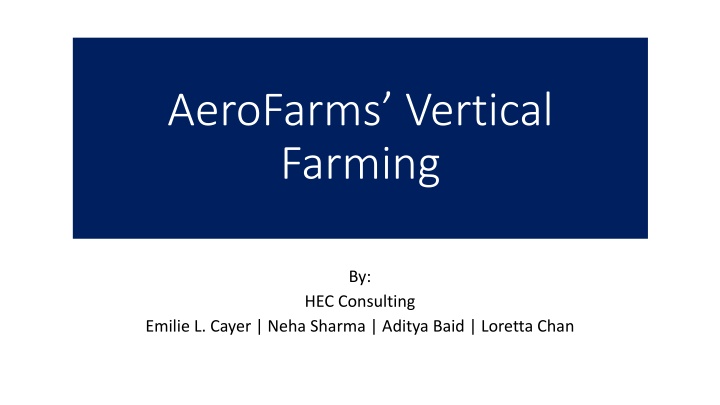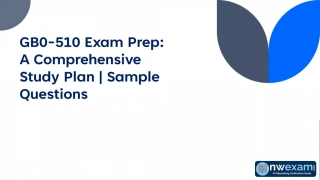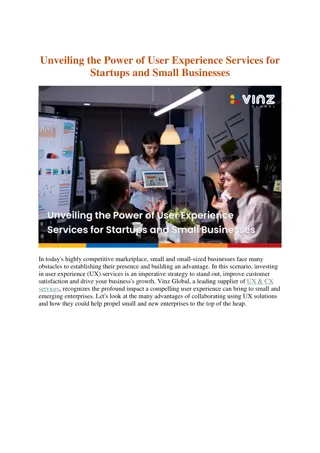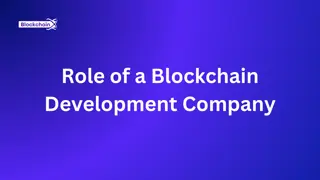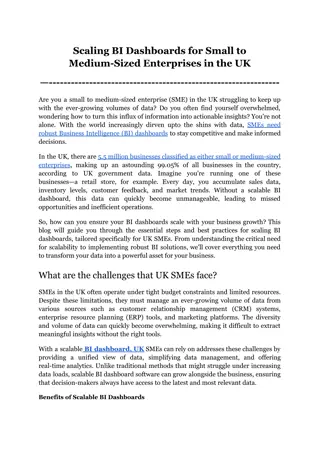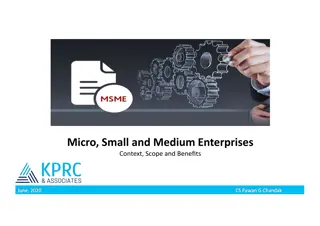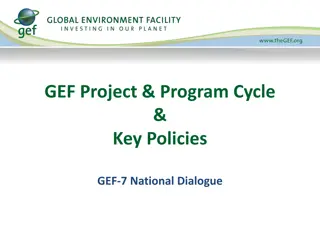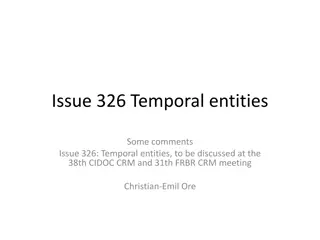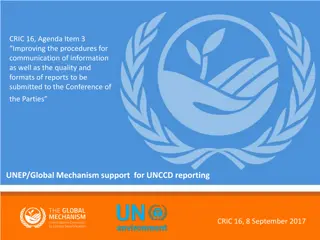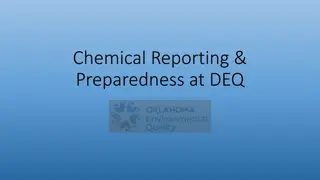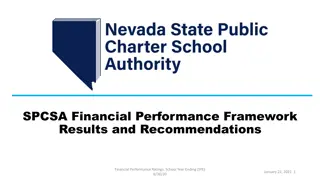Financial Reporting Framework for Small- and Medium-Sized Entities
An introduction to the Financial Reporting Framework for Small- and Medium-Sized Entities, a new special purpose framework developed by the AICPA. Learn why it was created, who can benefit from it, and how it differs from traditional frameworks like GAAP. Explore the basic features, understand who can use it, and discover the changes it brings to financial statements.
Download Presentation

Please find below an Image/Link to download the presentation.
The content on the website is provided AS IS for your information and personal use only. It may not be sold, licensed, or shared on other websites without obtaining consent from the author.If you encounter any issues during the download, it is possible that the publisher has removed the file from their server.
You are allowed to download the files provided on this website for personal or commercial use, subject to the condition that they are used lawfully. All files are the property of their respective owners.
The content on the website is provided AS IS for your information and personal use only. It may not be sold, licensed, or shared on other websites without obtaining consent from the author.
E N D
Presentation Transcript
AeroFarms Vertical Farming By: HEC Consulting Emilie L. Cayer | Neha Sharma | Aditya Baid | Loretta Chan
How can AeroFarms be profitable and sustainable in the future? Key Issues: Energy and technology challenges (ex. LED) Crop variety limitations High funding needed Limited talent and experts in vertical farming Problem Analysis Alternatives Implementation Conclusion
What are we proposing? Acquiring a competitor in vertical market farming (ex. Lufa Farms) Diversifying technology and products Expand in new geographies and the number of farms (increase market presence) Reaching goal of 25 farms by 2022 Market share increase by 9% in USA in aeroponic and aquaponic/ROI of 6.7% Problem Analysis Alternatives Implementation Conclusion
Agenda Analysis Alternatives Recommendation Implementation Financials Risks Conclusion Problem Analysis Alternatives Implementation Conclusion
What are the market forces? High High Low Barriers to entry Buyers Power Suppliers Power Medium Medium Complementary or substitute product Competitive market AeroFarms have to take advantage of the high barriers to entry and the high buyers power as well as reducing the competitive market Problem Analysis Alternatives Implementation Conclusion
What does the analysis tells us? Strengths Weaknesses Short product to market cycle time (near cities) Locally produced products Faster prototyping Use of data analytics 250 varieties of leafy vegetables 390 times-efficient to traditional farming (95% less water, less fertilizer and no pesticides) Patented technology Not affected by climate change High carbon emissions due to LED lights Limited protein options Limited talents and experts available Opportunities Threats Climate change and global social concerns Growing sensitivity to organic food in consumers Increasing purchasing power in urban areas Sensitivity to locally produced food Tough foreign investments rules in USA Needs for government incentives due to high cost of entries Increasing competition in vertical farming Need of high funding to be profitable on the market AeroFarms needs to capitalize on global social concerns and locally produced foods to overcome its limited protein options and high carbon emissions Problem Analysis Alternatives Implementation Conclusion
What alternatives did we consider? 1. Diversify vertical farming type through a partnership with competitor Enter a new type of vertical farming and increase the market presence (ex. Gotham Greens Farms LLC) 2. Partner with a complementary industry to increase efficiency and penetrate existing markets Use energy partner (ex. Tesla) or product partner (ex. Beyond Meat) 3. Expand in Asia with own capabilities (ex. Singapore and Hong Kong) 4. Enter the hydroponic or aquaponic market through an acquisition Acquire other competitors to own more farms and increase market presence Problem Analysis Alternatives Implementation Conclusion
What are the criteria? Implement 25 farms by 2022 Maintain Positive cash flow Reduce carbon footprint Increase market share Problem Analysis Alternatives Implementation Conclusion
Comparison of alternatives 25 farms by 2022 Positive cash flow Reduce carbon footprint Increase market share Diversify vertical farming type through a partnership with a competitor Medium Medium Medium High Partner with a complementary industry to increase efficiency and penetrate existing markets Medium Medium High Medium Expand in Asia with own capabilities Low Low Low High Enter the aquaponic or hydroponic market through an acquisition High Low Medium High Problem Analysis Alternatives Implementation Conclusion
What is the best for AeroFarms? 25 farms by 2022 Positive cash flow Reduce carbon footprint Increase market share Diversify vertical farming type through a partnership with a competitor Medium Medium Medium High Partner with a complementary industry to increase efficiency and penetrate existing markets Medium Medium High Medium Expand in Asia with own capabilities Low Low Low High Enter the aquaponic or hydroponic market through an acquisition High Low Medium High We recommend to expand the expertise of AeroFarms through the acquisition of competitors in different type of vertical farming Problem Analysis Alternatives Implementation Conclusion
What are we proposing? Acquiring a competitor in vertical market farming (ex. Lufa Farms) Diversifying technology and products Expand in new geographies and the number of farms (increase market presence) Reaching goal of 25 farms by 2022 Market share increase by 9% in USA in aeroponic and aquaponic Problem Analysis Alternatives Implementation Conclusion
Whom to acquire? Different type of vertical farming (hydroponic or aquaponic) Aquaponic is promising since it is a combination of hydroponic and fish farming High expertise and quality of production Compatible technologies New geographic locations These criteria need to direct any acquisition of AeroFarms The aquaponic is the most viable option Problem Analysis Alternatives Implementation Conclusion
Implementation plan Due diligence on Lufa Market share Business capabilities (employees, technologies and geographies) Negotiate and execute the acquisition Form: 100% acquisition Pricing: Based on total funding and revenue forecast (2.5x of funding) Share and cash deals (To shareholders of Lufa, they can benefit from potential profits from the expansion in North America and access to Aerofarms research data.) Problem Analysis Alternatives Implementation Conclusion
Implementation plan Set up 2 new pilot farms with combined aquaponic and aeroponic systems Diversified products (proteins and leaves) Cities: Montreal and New York Set up 9 new aeroponic farms in North America Cities: East (e.g., Boston and Detroit) and West (e.g., Seattle and LA) Problem Analysis Alternatives Implementation Conclusion
Communication plan Hire science and lifestyle influencers to promote AeroFarms Science influences (e.g., Veritasium with 8 million subscribers) Focus on processes, environmental sustainability and health and nutrients Lifestyle influencers (e.g., Emi Wong with 2 million subscriptions): Focus on quality and health brought by AeroFarms products Cooperate with corporate partners Delta Airlines: Fresh supply with the Newark farm Hotels: Supply to 5-star hotels Food producers: Beyond Meat Relate to Leonardo Dicaprio s moonshot to inspire and educate customers Problem Analysis Alternatives Implementation Conclusion
HR plan Communicate on the M&A Company direction Rewards from expansion Integration Communication channels between Aerofarms and Lufa Recruitment and training Promote the potential and sustainability of farming technologies Training on new technologies Problem Analysis Alternatives Implementation Conclusion
Implementation plan: Timing Item 2020 2021 2022 1H 2H 1H 2H 1H 2H Acquisition Due diligence on Lufa Negotiate and execute the acquisition Expansion Set up 2 pilot aquaponic and aeroponic farms Set up 9 new aeroponic farms Communication Hire science and lifestyle influencers to promote Cooperate with corporate partners Problem Analysis Alternatives Implementation Conclusion
Implementation plan: Costs Item 2020 2021 2022 Costs (in US$ million) 1H 2H 1H 2H 1H 2H Acquisition Due diligence on Lufa Negotiate and execute the acquisition Expansion Set up 2 pilot aquaponic and aeroponic farms Set up 9 new aeroponic farms Communication Hire science and lifestyle influencers to promote Cooperate with corporate partners Total 0.5 15 4 13.5 2 1 36 Problem Analysis Alternatives Implementation Conclusion
Finance: Assumptions Each farm is of the size of 2 acres in the urban area of a key city. The monthly rent is 0.25% of the building costs. AeroFarms will have 14, 17 and 25 farms in 2020, 2021 and 2022. The staff and administration costs and electricity cost are 25% and 12% of the total revenue. By 2020, electricity costs will reduce to 10% of total revenue due to increase in efficiency. Raw materials and R&D costs are each 10% of the total revenue. Lufa has 5 farms as of 2019. Problem Analysis Alternatives Implementation Conclusion
Finance: Project ROI: 6.7% Payback period: 2.9 years Total revenue of $161 million (diversified offerings) Total investments of $31 million (acquisition and set-up) Problem Analysis Alternatives Implementation Conclusion
Finance: Company-based Increase to 25 firms by 2022 through acquisition and expansion Increase in revenue by 178% Increase in net profit by 350% Problem Analysis Alternatives Implementation Conclusion
Market share in the US 18.5% in Aquaponic and Aeroponics by 2021 (an increase of 9% from 2019)
What are the risks? Risks What is the impact? What is the probability of occurring? How to mitigate? How to avoid? Company could refuse being acquired Start discussions early and adopt a win-win approach with high incentives Be ready to acquire another company High Medium Public not responding well to the raising carbon concerns Continue investing in R&D for aeroponic to reduce carbon concerns and diversifying into aquaponic to reduce overall carbon footprint Adopt a clear communication strategy to answer the growing concerns and continue investing in R&D Medium Medium Insufficient funding to acquire Use more percentage of stocks to go for the acquisition and strategize with the board to make the acquisition possible Be ready to acquire another smaller company to get the technology and expertise High Medium Insufficient talent pool for integrated farms Training of current staff with highest standards Strategize with education facilities to offer specific training programs in partnership High Medium Problem Analysis Alternatives Implementation Conclusion
What are you achieving by 2022? Acquisition of competitor Farming 4.0 25 farms Expanded expertise, geographic locations, farming types Higher variety of crops Higher market share (+9%)/ROI: 6.7% Problem Analysis Alternatives Implementation Conclusion
Thank you Questions? By: HEC Consulting Emilie L. Cayer | Neha Sharma | Aditya Baid | Loretta Chan
Appendix: Financials of Aerofarms The inflation rate is 2% per year. The tax rate is 30%.
Appendix: Financials of Aerofarms 2019 2020 2021 2022 (Base year) Revenue Costs Building Staff and administration (including training) Electricity Raw materials R&D Promotion and Distribution Due diligence Operating Profit Tax Net Profit 50 78 94 139 (11) (13) (6) (5) (5) (5) (14) (19) (8) (8) (8) (6) (1) 14 (4) 10 (21) (24) (9) (9) (9) (6) (31) (35) (14) (14) (14) (6) - 6 - - 16 (5) 11 25 (8) 18 (2) 4
